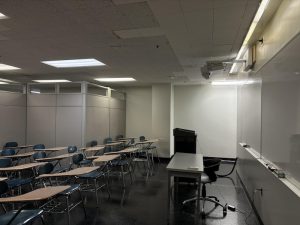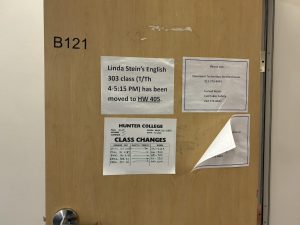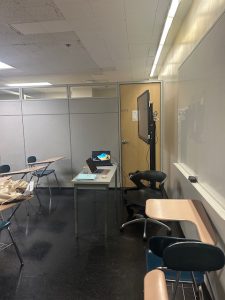
Stepping into the first level of the East building basement feels like entering a different dimension. Rows of tall bookshelves line the entirety of the level, their domino-like positioning occasionally disrupted by tables and cubicles occupied by busy students. The dim yellow lighting is a drastic change from the brightness of the white fluorescent lights of the East building’s upper floors. The first level is dedicated to quiet study but the murmurs of conversations carry their sounds to a hidden classroom, tucked into the furthest right corner of the basement.
EB 121 is technically a classroom: it has 28 chairs, a whiteboard, a podium, a projector, and a table. It could easily blend in with all the other rooms at Hunter College if not for the extreme lack of space due to an oddly positioned divider, which serves as the room’s walls. The divider is not flimsy, but it doesn’t reach the ceiling. There is a prominent gap that allows outside sound to travel inside easily; not even a closed door can help it, as of course it also doesn’t reach the ceiling. Despite the practical issues, the classroom is in current use, specifically by English professors.
“I’ve talked to several other instructors, and they’ve all been like ‘I had the worst time teaching there. It was awful. Get out.’… It seems to be a huge problem that just continues,” says Cullin Arn, a professor who teaches English 220 in EB 121. This is not the first time Arn was assigned this classroom, but it’s the first time she hasn’t been able to get out of teaching in it.

At the start of the semester, the room was even smaller as the divider split some of the space into another room labeled EB 121A. Too many desks overcrowded the space, with 28 desks for 25 students. The room also didn’t have a projector but only a small screen, which neither the professor nor the students knew how to use. On top of that, the professor’s table was pushed too close to the whiteboard, making writing on it impractical.
“Students would have to jump over desks to get into the back, to sit in seats, and there was no room for me up front,” says Arn.
The lack of space is also an accessibility issue. Students who are tall or bigger are squeezed into their desks – if they’re able to get to them. If a student with a wheelchair is a part of the class, desks would have to be moved to create appropriate space for them, which would leave other students with no seats. EB 121 is not usable by anyone who can’t perform physical activity or wedge through approximately 10 inches of space.
“If I have, let’s say, the length of my hand, that’s about how much room is between each desk or each little crevice there. And because they’ve jam packed so many desks into that room, there’s not a lot of maneuverability,” says Robert Rada, 19, who’s taking the English 220 class Arn teaches.
The state of the room is significantly better now as Arn was able to receive help from the English Department Chair, Paul McPherron, and the Administrative Specialist, Angelo Nikolopoulos. They were proactive in making small changes to make the room more “palatable to humans.” They removed some of the divider, which got rid of EB 121A but created an awkward and unusable corner. They also added a projector and removed the screen. However, they could not do anything to help with switching the rooms. According to Arn, it wasn’t under their control.

As paraphrased by Arn from her conversations with the two men, the ‘scheduling office’ has authority over room assignment. Searching the ‘scheduling office at Hunter College’ produces no email, office number, or further information. However, the Registrar’s web page states they handle class and room assignments. Fortunately, they do have an email and an office. The confusion around which office and department handles what responsibilities at Hunter College is another roadblock to getting efficient help in resolving issues that students and professors face.
Aside from the lack of space, the noise issue persists as well. Behind EB 121 is EB 120, a makeshift office for the Director of the Socrates Center. Arn and Rada have reported hearing a meeting happening in EB 120 during the middle of their class time. Though it only happened once, it created an understandable disruption in the flow of class discussion. A more frequent disruption is the bleeding-over of noise from the students occupying the rest of the basement.
“I just think there’s got to be an alternative here, you know, especially for a class like this. You have to discuss … literature that maybe we haven’t read [before]. So it helps to maybe have it in an actual room,” says Rada.
The case of EB 121 speaks to a larger space issue at Hunter College. There are over 20,000 students, insufficient room space, and departments left scrambling for alternative answers. One of the potential solutions could be a change in the bell schedule, so there are no strange gaps of time where some classrooms are empty but can’t be used. A new proposition was drafted by the Hunter College Senate that could provide some resolution to these issues by changing class times and allocating the Community Hour, a time reserved for student activities, to Friday, instead of Tuesday and Wednesday. However, the resolution’s passing is still up in the air.

“There have been instances where students can’t take a class because it’s only offered in one semester and they need it to graduate,” says Adriana Pavlidis-Sanchez, 21, president of the Undergraduate Student Union. “This is supposed to help those students, and also just help departments stay more on track. It impacts literally everyone on campus.”

